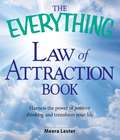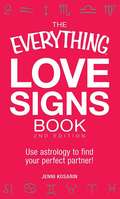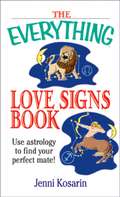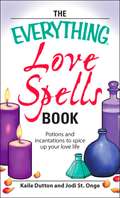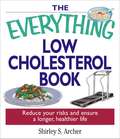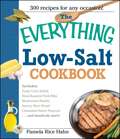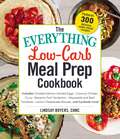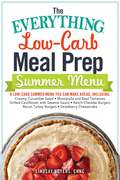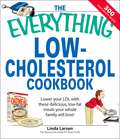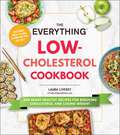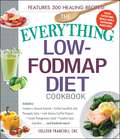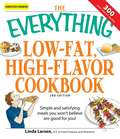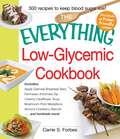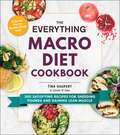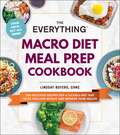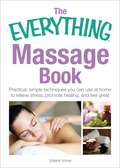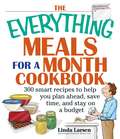- Table View
- List View
The Everything Law of Attraction Book
by Meera LesterIf you believe it, it will come . . . that's the Law of Attraction - and this ancient concept is attracting more attention than ever. This book picks up where The Secret leaves off and begins with an exploration of the historical, cultural, and religious presence of the Law of Attraction. The book then draws upon the self-help elements to provide practical strategies on how to retrain the mind to achieve specific life goals. Packed with fun and enlightening exercises and tools, you will learn how to use your thoughts to attract the perfect partner, chart a course for success in career, become a money magnet, banish stress, and more. With an appendix full of self-help worksheets to support you on your journey, you will have all you need to put the Law of Attraction to work for you.
The Everything Law of Attraction Book (The Everything )
by Meera LesterIf you believe it, it will come...that's the Law of Attraction - and this ancient concept is attracting more attention than ever. This book picks up where The Secret leaves off and begins with an exploration of the historical, cultural, and religious presence of the Law of Attraction. The book then draws upon the self-help elements to provide practical strategies on how to retrain the mind to achieve specific life goals. Packed with fun and enlightening exercises and tools, you will learn how to use your thoughts to attract the perfect partner, chart a course for success in career, become a money magnet, banish stress, and more. With an appendix full of self-help worksheets to support you on your journey, you will have all you need to put the Law of Attraction to work for you.
The Everything Law of Attraction Dream Dictionary (The Everything )
by Cathleen O'ConnorTurn dreams into goals and goals into reality with this dictionary! With this valuable guide you’ll learn to channel the power of the Law of Attraction as you sleep. You’ll identify your own symbolic dream language, and access the secrets of your subconscious. Once you realize your true desires, you can apply Law of Attraction principles and dream your way to:Create healthy relationshipsAttract success in your careerManifest an abundance of wealthFind--and keep--the perfect partnerEliminate stress and improve your healthWith more than 800 dream symbols and themes, this comprehensive resource is all you need to make your dreams come true!
The Everything Love Signs Book
by Jenni KosarinDress conservatively to attract a Pisces.Impress a Sagittarian with good wine and ethnic food.Want to know if a Scorpio is interested? Flirt with his friend!Every sun sign has its own allure, passions, and desires. With this guide, you'll learn which one is the perfect match for you! You'll also learn the secrets of attracting and pleasing any sign, including how to:Find the best (and avoid the worst) sun-sign matchesAct and dress to be irresistible to any sign Predict your lover's likes and dislikesMake your partner a better lover With in-depth quizzes and descriptions of the relationship characteristics, dating habits, and compatible matches of each sign, this entertaining guide will bring you a truly cosmic love life!
The Everything Love Signs Book
by Jenni KosarinLooking for signs that your partner is good in bed? How do you guarantee that perfect intellectual match? Whether you're a stubborn Taurus, an unpredictable Gemini, an aggressive Aries, or a sunny Leo, The Everything Love Signs Book is the perfect guide to help you find true love and romance. The Everything Love Signs Book shows you how to: - Identify a compatible partner; - Become irresistible to any sign; - Predict a lover's habits and peeves; - Seduce a prospect based on astrological characteristics. Practical and endlessly entertaining, The Everything Love Signs Book is better than a dating service!
The Everything Love Signs Book: Use Astrology to Find Your Perfect Mate
by Jenni KosarinA Simon & Schuster eBook. Simon & Schuster has a great book for every reader.
The Everything Love Signs Book: Use astrology to find your perfect partner!
by Jenni KosarinDress conservatively to attract a Pisces.Impress a Sagittarian with good wine and ethnic food.Want to know if a Scorpio is interested? Flirt with his friend!Every sun sign has its own allure, passions, and desires. With this guide, you'll learn which one is the perfect match for you! You'll also learn the secrets of attracting and pleasing any sign, including how to:Find the best (and avoid the worst) sun-sign matchesAct and dress to be irresistible to any sign Predict your lover's likes and dislikesMake your partner a better lover With in-depth quizzes and descriptions of the relationship characteristics, dating habits, and compatible matches of each sign, this entertaining guide will bring you a truly cosmic love life!
The Everything Love Spells Book: Spells, incantations, and potions to spice up your love life (Everything® Series)
by Kaile Dutton Jodi St. OngeBring love into your life and keep it there with The Everything Love Spells Book. This pocket guide contains more than 75 spells to help you rev up your romance. There's a spell for every lover's lament: -Can't get over that last love? Do the Breaking the Chains Spell and he's gone for good! -Need to attract that special someone? The Enhancement Spell will make anyone irresistible! -Bored in the bedroom? All you need to stoke the flames is the Tantric Lovemaking Spell! Whether you're an experienced spellcaster or dabbling in magick for the first time, watch love flourish with these and many other spells. Nudge that special someone along, and add passion and erotic excitement to your existing relationships. True love is just a spell away!
The Everything Low Cholesterol Book
by Shirley ArcherEach year in America, more than one million people suffer from heart attacks caused by high cholesterol-and half a million die from related heart disease. Don't become a statistic-take control of your health now! The Everything Low Cholesterol Book provides everything from information on how to create a sensible diet and fitness plan to practical tips for improving your overall well-being. This comprehensive, authoritative guide edited by Sandra K. Nissenberg, M.S., R.D., provides you with all the information you need to lower your cholesterol and reduce your risk of a heart attack. Features timely, reliable information on: The differences between "good" and "bad" cholesterol; The effects of high cholesterol and artery blockage; Suggestions to improve your overall health; Nutrition and exercise tips to keep you fit and well; Up-to-date government cholesterol guidelines. Also including more than seventy-five heart-healthy recipes for the whole family, The Everything Low Cholesterol Book provides you with all the up-to-the-minute information to keep you informed and healthy.
The Everything Low Cholesterol Book: Reduce Your Risks And Ensure A Longer, Healthier Life
by Shirley ArcherA Simon & Schuster eBook. Simon & Schuster has a great book for every reader.
The Everything Low Salt Cookbook Book: 300 Flavorful Recipes to Help Reduce Your Sodium Intake
by Pamela Rice HahnAccording to the American Dietetic Association, Americans consume three times the suggested daily salt intake. For many people, too much salt can cause a host of medical conditions including high blood pressure, which can lead to heart disease and stroke. Featuring 300 delicious low-salt meals that would please even the pickiest eater, The Everything Low-Salt Cookbook also provides specific instructions on how to eat, what to eat, and how to curb those between-meal salt cravings.The quick-and-easy cookbook features:Appetizers, such as Sweet Stuff Guacamole DipSeafood, such as Baked Orange Roughy in White WineUnique sandwiches, such as Meat-Tofu Burgers with CheeseEthnic cuisine, such as Curried CouscousHealthy desserts, such as Veggie-Fruit SaladFeaturing important dietary information such as calorie counts, fat grams, carbohydrates, protein, and sodium for each recipe, The Everything Low-Salt Cookbook will have you throwing out your salt shakers and serving up flavorful dishes for everyone!
The Everything Low-Carb Meal Prep Cookbook: Includes: •Smoked Salmon Deviled Eggs •Coconut Chicken Curry •Balsamic Pork Tenderloin •Mozzarella and Basil Tomatoes •Lemon Cheesecake Mousse …and hundreds more! (The Everything)
by Lindsay Boyers300 fresh, simple, and easy recipes that combine the benefits of the popular meal-prep trend with the long-standing success of the low-carb diet—as well as a two-week meal plan and shopping guide to make cooking a snap!Following a low-carb diet is a great way to get in shape and lose weight. However, it can be hard to cut out familiar staples such as pasta, bread, and other carb-rich foods. That’s where meal prepping comes in. By making all of your food ahead of time, you can protect your diet against impulsive cravings for carbs. The Everything® Low-Carb Meal Prep Cookbook will show you how, with a little advance planning, you can create healthy, low-carb meals for every day of the week to control exactly what you eat. With 300 delicious recipes, you’ll find it easier than ever to get into the habit of prepping your meals—and you’ll save time and money while starting on the path to a healthier diet.
The Everything Low-Carb Meal Prep Summer Menu: A Low-Carb Summer Menu You Can Make Ahead, Including: * Creamy Cucumber Salad * Mozzarella and Basil Tomatoes * Grilled Cauliflower with Sesame Sauce * Ranch Cheddar Burgers * Bacon Turkey Burgers * Strawberry Cheesecake (The Everything)
by Lindsay BoyersMake summertime living even easier with these six delicious—and low-carb—recipes you can prepare ahead of time.Get the burgers ready and fire up the grill! In this ebook, you’ll find six delicious recipes that you can prepare in advance for the perfect summer meal. By combining the benefits of a low-carb diet with the ease of meal prepping, you can have a tasty—and healthy!—meal without giving up that beach body you worked so hard for during the cold winter months—and have a full meal ready just as everyone arrives for your next cookout. Spend less time around the grill and more time in the pool this summer with The Everything Low-Carb Meal Prep Summer Menu!
The Everything Low-Cholesterol Cookbook
by Linda LarsenEach year in America, more than one million people suffer from heart attacks caused by high cholesterol - and half a million die from related heart disease. Don't become a statistic - take control of your health now! The Everything Low Cholesterol Cookbook provides everything from information on how to create a sensible diet and fitness plan to practical tips for improving your overall well-being. This comprehensive, authoritative guide edited by Sandra K. Nissenberg, M.S., R.D., provides you with all the information you need to lower your cholesterol and reduce your risk of a heart attack.Features timely, reliable information on:The differences between "good" and "bad" cholesterolThe effects of high cholesterol and artery blockageSuggestions to improve your overall healthNutrition and exercise tips to keep you fit and wellUp-to-date government cholesterol guidelinesAlso including more than seventy-five heart-healthy recipes for the whole family, The Everything Low Cholesterol Cookbook provides you with all the up-to-the-minute information to keep you informed and healthy.
The Everything Low-Cholesterol Cookbook: 200 Heart-Healthy Recipes for Reducing Cholesterol and Losing Weight (Everything®)
by Laura LiveseyKeep your cholesterol levels in check and reduce your risk for developing heart disease and other chronic conditions with these 200 healthy and satisfying low-cholesterol recipes. Is your health care professional concerned about your high blood cholesterol levels? Do you worry that excess weight could have a detrimental effect on your health? Or are you simply looking for a healthier lifestyle? Changing your diet is the most effective way to lose weight and reduce your cholesterol level and The Everything Low-Cholesterol Cookbook is here to help! This cookbook is your introduction to the benefits of a heart-healthy diet. Learn about cholesterol and its role in heart disease, how lifestyle changes can reduce your risk of heart disease and other chronic conditions, and how losing excess weight can improve your health. You&’ll also find 200 recipes for satisfying dishes that focus on a rainbow of vegetables and fruits, healthy fats, and satisfying proteins. Each recipe is low in sugar but high in flavor, so you don&’t have to sacrifice delicious foods to be healthy!
The Everything Low-Cholesterol Cookbook: Keep you heart healthy with 300 delicious low-fat, low-carb recipes
by Linda LarsenEach year in America, more than one million people suffer from heart attacks caused by high cholesterol - and half a million die from related heart disease. Don't become a statistic - take control of your health now! The Everything Low Cholesterol Cookbook provides everything from information on how to create a sensible diet and fitness plan to practical tips for improving your overall well-being. This comprehensive, authoritative guide edited by Sandra K. Nissenberg, M.S., R.D., provides you with all the information you need to lower your cholesterol and reduce your risk of a heart attack.Features timely, reliable information on:The differences between "good" and "bad" cholesterolThe effects of high cholesterol and artery blockageSuggestions to improve your overall healthNutrition and exercise tips to keep you fit and wellUp-to-date government cholesterol guidelinesAlso including more than seventy-five heart-healthy recipes for the whole family, The Everything Low Cholesterol Cookbook provides you with all the up-to-the-minute information to keep you informed and healthy.
The Everything Low-FODMAP Diet Cookbook: Includes Cranberry Almond Granola, Grilled Swordfish with Pineapple Salsa, Latin Quinoa-Stuffed Peppers, Fennel Pomegranate Salad, Pumpkin Spice Cupcakes...and Hundreds More! (Everything®)
by Colleen FrancioliDelicious recipes and meal plans to ease symptoms and improve digestion If you are suffering from symptoms of IBS, you know that digestive troubles and pain can disrupt your day-to-day life. Fortunately, scientists have discovered that FODMAPs, a collection of short-chain carbohydrates that are difficult to digest, are often the source of these digestive issues. FODMAPs are found in many common foods, like wheat, milk, beans, and some vegetables, fruits, and sweeteners.The Everything Low-FODMAP Diet Cookbook includes 300 delicious low-FODMAP and gluten-free recipes, including:Cranberry Almond GranolaStrawberry Coconut Almond SmoothieQuinoa, Corn, and Zucchini FrittersCoconut Curry Lemongrass SoupRoasted Parsnips with RosemaryBlueberry-Glazed ChickenCitrus Flank SteakGrilled Swordfish with Pineapple SalsaMexican RisottoSpiced Pumpkin CupcakesWith these recipes and an extensive meal plan, you'll be able to identify your sensitivities, eliminate problem foods, and control symptoms. Create your own personalized and realistic eating plan to improve your health and enjoy your favorite meals again.
The Everything Low-Fat, High-Flavor Cookbook
by Linda LarsenGood fat. Bad fat. Trans fat. Eating a balanced low-fat diet has never seemed so complicated. This cookbook makes it easy with 325 flavor-packed recipes anyone can master. No one will feel like they are sacrificing when they learn to make these delicious recipes: Nutty Chicken Fingers; Orange Beef and Broccoli Stir-Fry; Poached Cod with Spicy Buttermilk Sauce; Oven-Baked Fries; Risotto with Winter Squash; Lemon Meringue Pie; Peanut Butter Chocolate Bars; and more! This edition includes completely new material, such as 25 brand-new recipes, nutritional stats for all recipes, and recipes that all conform to new USDA standards. Finally, "good for you" also means great tasting!
The Everything Low-Fat, High-Flavor Cookbook
by Linda LarsenGood fat. Bad fat. Trans fat. Eating a balanced low-fat diet has never seemed so complicated. This cookbook makes it easy with 325 flavor-packed recipes anyone can master. No one will feel like they are sacrificing when they learn to make these delicious recipes: Nutty Chicken Fingers; Orange Beef and Broccoli Stir-Fry; Poached Cod with Spicy Buttermilk Sauce; Oven-Baked Fries; Risotto with Winter Squash; Lemon Meringue Pie; Peanut Butter Chocolate Bars; and more! This edition includes completely new material, such as 25 brand-new recipes, nutritional stats for all recipes, and recipes that all conform to new USDA standards. Finally, “good for you” also means great tasting!
The Everything Low-Glycemic Cookbook
by Carrie S. ForbesAn easy-to-follow plan for healthy weight loss! If you're tired of sugar-free this and low-carb that, constantly restricting your diet to lose weight and stay healthy, The Everything Low-Glycemic Cookbook is the perfect choice for you! According to experts, switching to a low-glycemic index (GI) diet is the key to losing weight--and keeping it off. The GI diet isn't a low-fat diet; you won't find calorie counting or reduced portion sizes. In fact, following the low-GI diet just means eating more low-glycemic foods and avoiding others that have a high GI number. Popular food blogger Carrie Forbes has compiled 300 low-GI meals that are as tasty as they are healthy, including: Strawberry-banana pancakes Spicy cilantro dip Butternut squash soup Poached chicken with pears and herbs Country-style pork ribs Easy vegetarian lasagna with spinach Grilled lemon-and-dill swordfish steaks Peanut butter-chocolate chip cupcakes Armed with glycemic index values of common foods and hundreds of recipes for satisfying, delicious dishes, you'll have all you need to lose weight and eat well--every meal of the day!
The Everything Low-Glycemic Cookbook: Includes Apple Oatmeal Breakfast Bars, Parmesan Artichoke Dip, Creamy Cauliflower Soup, Mushroom Pork Medallions, Almond Cranberry Biscotti ...and hundreds more!
by Carrie S ForbesAn easy-to-follow plan for healthy weight loss!If you're tired of sugar-free this and low-carb that, constantly restricting your diet to lose weight and stay healthy, The Everything Low-Glycemic Cookbook is the perfect choice for you! According to experts, switching to a lowûglycemic index (GI) diet is the key to losing weight--and keeping it off. The GI diet isn't a low-fat diet; you won't find calorie counting or reduced portion sizes. In fact, following the low-GI diet just means eating more low-glycemic foods and avoiding others that have a high GI number.Popular food blogger Carrie Forbes has compiled 300 low-GI meals that are as tasty as they are healthy, including:Strawberry-banana pancakesSpicy cilantro dipButternut squash soupPoached chicken with pears and herbsCountry-style pork ribsEasy vegetarian lasagna with spinachGrilled lemon-and-dill swordfish steaksPeanut butterûchocolate chip cupcakesArmed with glycemic index values of common foods and hundreds of recipes for satisfying, delicious dishes, you'll have all you need to lose weight and eat well--every meal of the day!
The Everything Macro Diet Cookbook: 300 Satisfying Recipes for Shedding Pounds and Gaining Lean Muscle (Everything®)
by Tina HaupertStop counting calories and transform your body while eating all the foods you love with The Everything Macro Diet Cookbook! You can finally stop counting calories and start eating foods that bring you joy! With the macro diet, no food is off limits. You can eat just about anything, just in specific portion sizes and still lose weight and gain lean muscle. The Everything Macro Diet Cookbook is an introduction to this flexible diet that can help anyone lose weight without having to avoid your favorite foods that may contain fats or carbs. Based on the simple formula that balances the daily intake of protein, fat, and carbohydrates, the macro diet is gaining in popularity as people discover they can shed pounds without feeling deprived. The Everything Macro Diet Cookbook not only includes an introduction to the diet that is changing lives, but also 300 recipes for every meal and sample meal plans to make shopping and meal prep easier than ever! This book gives you all you need to transform your body while eating what you love!
The Everything Macro Diet Meal Prep Cookbook: 200 Delicious Recipes for a Flexible Diet That Helps You Lose Weight and Improve Your Health (Everything®)
by Lindsay BoyersStop counting calories and transform your body in no time with these easy, make-ahead macro diet meals everyone will enjoy.If you&’re someone who wants to start making healthy choices and get in control of your diet, you&’re not alone. The macro diet offers a specific number of proteins, carbs, and fats to stay under every day based on your goals. Rather than a strict calorie count, which can do more harm than good, this way of eating allows you to enjoy all of your favorite foods—as long as it&’s within your macros. All you need to be successful with this diet is organization and preparation and The Everything Macro Diet Meal Prep Cookbook is here to help. This customizable, sustainable, and most importantly, effective diet will help you reach your weight-loss goals by cooking and eating healthy meals all week long.
The Everything Massage Book: Practical, simple techniques you can use at home to relieve stress, promote healing, and feel great
by Valerie VonerMassage has been proven to reduce stress, promote healing, and enhance healthful living. Unfortunately, spas and massage therapies can be prohibitively expensive. The Everything Massage Book provides readers with all they need to put professional massage techniques to use in their own homes. Packed with easy-to-follow instruction, this reader-friendly guide presents the many benefits of massage and addresses the ten most popular techniques, including Swedish and shiatsu massage.
The Everything Meals For A Month Cookbook: Smart Recipes To Help You Plan Ahead, Save Time, And Stay On Budget (Everything® Series)
by Linda LarsenYou don't have to order take out every time you don't feel like cooking - now there's an easier way to have breakfast, lunch, and dinner (not to mention dessert) right at your fingertips! The Everything Meals for a Month Cookbook is the perfect tool to help you save time in the kitchen (and money in your wallet) with practical shopping tips and food handling tricks for buying and cooking in bulk. Learn how to plan your menu, assemble the ingredients, and store and freeze a month's worth of dinners - without losing any freshness or taste. In addition to 300 mouth-watering recipes, The Everything Meals for a Month Cookbook explains how you can organize your kitchen for once-a-month cooking. Thanks to the easy-to-follow bulk-cooking model provided, it's easier than you think!Features family-friendly recipes such as:Cranberry OatmealQuick BreadStuffed MushroomsSanta Fe Chicken SoupCurried Turkey CasseroleApple Glazed Pork RoastShrimp Pesto LinguineGerman Chocolate Pound CakeWhether you're serving up these delicious meals straight from the oven or freezing them for later in the month, you'll find everything you need to save time and money with The Everything Meals for a Month Cookbook.
